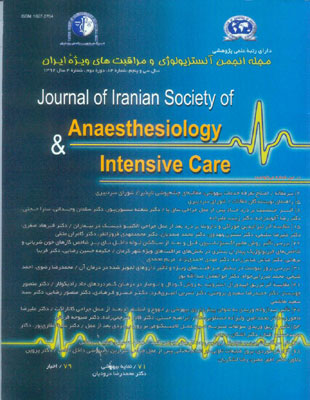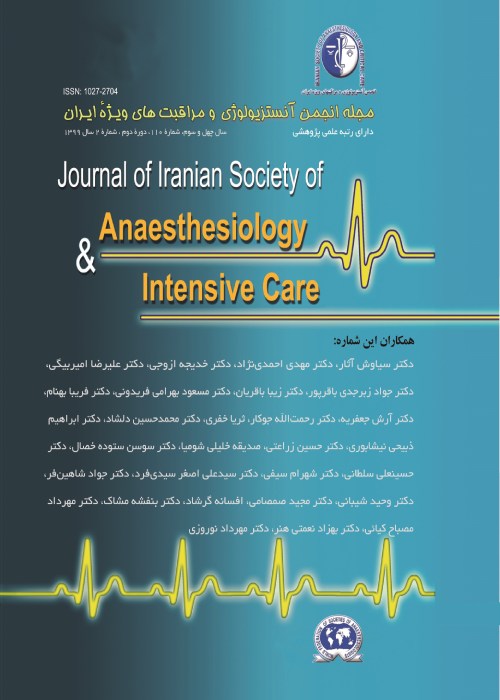فهرست مطالب

فصلنامه آنستزیولوژی و مراقبتهای ویژه ایران
سال سی و پنجم شماره 4 (پیاپی 84، زمستان 1392)
- تاریخ انتشار: 1392/11/10
- تعداد عناوین: 12
-
-
صفحه 71
-
صفحه 79
-
Page 8Introduction
One of the most common complications of surgery is postoperative pain. Effective control of postoperative pain is important for anesthesiologists and surgeons. Because there is no general agreement on gender differences in pain perception، the purpose of this study is to compare the effect of gender on acute pain after tibial fracture surgery.
Materials And MethodsSpinal anesthesia was performed in the same manner in 102 patients candidated for tibial fracture surgery (51 males and 51 females). 2، 4، 8، 12 and 24 hours after surgery، pain scores were recorded according to the VAS criteria. First requested analgesic and the total amount of analgesic were recorded.
ResultsResults showed that in the first 8 hours after surgery، women reported significantly more pain (p<0. 05). During the next hours، pain was greater in women but not statistically significant (p>0. 05). Time of the first analgesic requested earlier in women than men (p<0. 05). The total amount of analgesic intake was significantly greater in women (p<0. 05).
ConclusionWomen experience more intense pain after tibial fracture surgery and need more analgesic in the postoperative period.
Keywords: Acute postoperative pain, gender, pain, tibial fracture surgery -
Page 15IntroductionLumbar discectomy is a common elective surgical procedure. Many patientsexperience postoperative back pain which may delayhospital discharge. α2-agonist، inhibit pain sensation by inhibiting norepinephrine release from dorsal horn neuron in accordance with prolongation of analgesia and decreasing analgesic morphine requirements. The aim of this study was to assess the effect of tizanidine on the intensity of pain and equirement for analgesics for relief of postoperative pain after lumbar disc surgery.Materials And MethodsEighty patients with single-level unilateral herniated disc that wererefractory to conservative management، and undergoing lumbar disc surgery under standard general anesthesia were enrolled. Forty patients received pre-operative oral Tizanidine and forty patients received placebo. Besides، all patients received patient controlled morphine pump for postoperation analgesia. Pain was measured usingnumerical rating scale (NRS) at 1، 3، 6، 12 and 24 hours post-operation. Total morphine requirement was also measured.ResultsPost-operative pain score (NRS) wassignificantly lower at 6 hour (p= 0. 01)، 12 (p= 0. 027) and 24 hours (p= 0. 015). Total 24 hours morphine requirement (rescue analgesic) was also significantly lower in Tizanidine than in control (p= 0. 02).ConclusionPre-operative use of tizanidine prior to lumbar disc herniation surgery maintains effective post-operative analgesia and decreases morphinerequirement without major or minor complications.Keywords: Postoperative pain, analgesia, lumbar discectomy
-
Page 22IntroductionEٍndotracheal suctioning is a method to remove secretions from the airway in patients who can not perform this voluntarily and have an artificial airway. Suctioning is frequently used in the ICUs and can result in many complications if not performed properly. The aim of this study was to compare the effects of hyperoxygenation on arterial blood gases before and after endotracheal suctioning.Materials And MethodsIn this study, 36 patients admitted to the intensive care ward of Bahonar and Afzalipour hospitals that have inclusion criteria were chosen. The subjects were studied in acrossover design. The data collection form was used to record. This form has 2 parts: 1) demographic characteristics and 2) table to record the results of arterial blood sampling and continuous monitoring parameters in patients. Patients were randomly assigned to suctioning with lung hyperoxygenation and combination of hyperoxygenation and hyperinflation before and after suctioning. Arterial blood gases and physiological parameters were recorded pre-intervention and immediately and 30 minutes after intervention. Data were analyzed with SPSS software.ResultsSuctioning with both methods can increase PaO2 and O2 saturation immediately and 30 minutes after the suction. However, an increase with combined method is more sensitive. Hyperoxygenation can increase mean of paCO2 immediately and 30 minutes after thesuction but combination of hyper oxygenation and hyperinflation can decrease it. Hyperoxygenation can decrease pH immediately and 30 minutes after the suction but combination of hyper oxygenation and hyperinflation can increase it. Suctioning with both methods can decrease HCO3 however decreasing with hyperoxygenation is moresensitive. Physiological parameters determined immediately and 30 minutes after using a combination of suction with hyperoxygenation and hyperinflation were significantly higher than those with the hyperoxygenation suction method.DiscussionThis study showed that the effect of lung hyper oxygenation and combination of hyper oxygenation and hyperinflation on some of the arterial blood gas and physiological parameters beforeand after endo tracheal suctioning is variable. Among the most important is the influence an oxygen and blood pH. So suctioning can be done suctioned out with either of these two methods, depending on the specific clinical situation of the patients.Keywords: Endotracheal suctioning, hyper oxygenation, hyperinflation, blood gas, physiological parameters
-
Page 31IntroductionGastrointestinal motility disorders are considered one of the most common digestive problems in the intensive care units that mainly appear as decreased gastrointestinal motility and constipation. The current study is to evaluate theincidence of constipation in the intensive care unit and effect of medications to treat it.Materials And Methods31 patients were studied. Inclusion criteria were age≥ 18 years، hospitalization in the intensive care unit for more than three days، receiving enteral nutrition and non-malignant gastro intestinal or stomach surgery. Evaluation criteria forconstipation was lack of gastrointestinal excretion for three consecutive days.ResultsConstipation occurred in 61. 3% (n=19) of the patients. There was no difference between constipated and not constipated in terms of sex، age، Acute Physiology and Chronic Health Evaluation II، mechanical ventilation، sedation and opiate use. Incidence of constipation with increased length of stay in the intensive care unit were significantlycorrelated (11. 5±5 days vs. 6. 5±5 days). There was no difference between patient using laxative and other patients in the incidence of constipation.ConclusionDespite medical treatment، constipation in ICU، had a high incidence that increased duration of hospitalization. Several factors influencing the incidence of constipation and lack ofatreatment protocol from doctors and nurses is the most important reason for the high prevalence of constipation.Keywords: Intensive care, laxative, constipation
-
Page 41IntroductionLow back pain is the most common symptom that requires medical care and causes musculoskeletal morbidity and many social and economic inconveniences. Epidural steroid injection for low back pain is a common treatment. Due to the ease of the technique and less complications for caudal epidural steroid injection this study compares the relative effectiveness of caudal versus standard lumbar procedure.Materials And MethodsIn this randomized، double-blind clinical trial of 68 patients aged 60-20 years with Class 1 and 2 ASA radicular back pain symptoms were divided into two groups based on assessment of pain on a visual Analog Score (VAS). Oswestry disability index (ODI) and general questions SF-36 was completed. The lumbar region in control group and the sacral hiatus in the study group were selected for injection. The results were analyzed. P<0. 05 was considered significant.ResultsIn both groups there was a significant difference according to VAS before and one week and one month after injection. Similar results were obtained in two groups based on the Oswestry disability index questionnaire. Finally، both in the treatment group relative measure of progress wasachieved with regard to the physical part of SF-36 questionnaire، but there was no significant difference between the two groups at the same time (p> 0. 05).ConclusionBoth injection methods can improve the quality of life and reduce the severity of pain anddisability in patients and there was no significant difference between the injection methods and anyone can be used depending on the situation.Keywords: Low back pain, corticosteroids, epidural, caudal, lumbar
-
Page 48IntroductionPostoperative nausea and vomiting is a common postoperative complication after ophthalmic surgeries. This randomized and doubleblind study was designed to evaluate the efficacy of midazolam in reducing the incidence of postoperative nausea and vomiting.Materials And MethodsSixty ASA I، II adult patients، scheduled for elective cataract surgery، under general anesthesia were enrolled. No premedication was given. Anesthesia was induced with sodium thiopental. After induction، fentanyl 1 μ/ kg and atracurium 0. 6 mg/ kg were administered and an endotracheal tube was inserted. Afterinduction of anesthesia and before start of surgery، patients were randomly allocated into two groups، each to receive placebo and midazolam 20 μ/ kg. Episodes of nausea، and vomiting were recorded during the first 24 h after surgery.ResultsThe incidence of postoperative nausea was 27. 7% and 23. 3% with placebo and midazolam respectively (p=0. 35). The incidence of vomiting was 16. 7% and 10% with placebo and midazolamrespectively (p=0. 19).ConclusionThe results of this study showed a relative reduction in the incidence of postoperative nausea and vomiting after midazolam premedication. But this finding wasn''t statistically significant. Further investigations with larger samplesize was recommended. Keywords: Postoperative Nausea and Vomiting، Midazolam، Cataract Surgery
-
Page 54IntroductionPost operative pain control is a major concern for physicians and patients. Magnesium has antinociceptive effects based on the regulation of calcium influx into the cell ie. natural physiological calcium antagonism and antagonism of the N-methyl- D- aspartate receptor. We conducted this study to evaluate the analgesic efficacy of magnesium sulfate on post operative analgesic requirements of laminectomy patients.Materials And MethodsAfter obtaining informed consent، we studied 40 ASA physical status I and II patients undergoing laminectomy، in a double blind clinical trial. After the induction of anesthesia with the same method، the patients received either magnesium sulfate 30mg/kg Iv as a bolus before the start of surgery and 10mg/kg/hr by a continuous Iv infusion with a syringe pump over the entire operation period or the same volume of isotonic sodium chloride solution. When surgery was complete، patients were equipped with a PCA with the initial settings of a demand bolus dose of morphine 1mg and lock out interval 15 min. Patients first analgesic requirement time، 24 hour morphineconsumption، and pain score using a standard 10 point VAS were made at 6، 12، 18 and 24 hr in the post operative period and recorded.ResultsThe morphine consumption during the first 24 hours was 0. 7mg/kg in the control group and 0. 59 mg/kg in the magnesium sulfate group (p=0. 23). Patients’ mean first analgesia requirement time were3. 73 hour in control group and 3. 61 hour in magnesium group (p=0. 79). VAS scores for pain at 6، 12، 18 and 24 hours post operatively were similar in both groups.ConclusionMagnesium sulfate infusion during laminectomy did not have any effect on patients pain and opioid requirement in the first 24 hour.Keywords: Magnesium sulfate, laminectomy, PCA
-
Page 60IntroductionConventional wisdom suggests that smoking causes decreased postoperative wound healing and systemtic complications. The goal of the current study was to evaluate the effect of smoking on mortality and morbidity rates after cardiac surgery.Materials And MethodsThis descriptive study was prospectively carried out over 3 months on 130 consecutive cardiac surgery patients (35% smoker 11/9% less than 5years، 23/1% more than 5 years، 65% nonsmoker) who were admitted in EmamReza''s university hospital in Mashhad. Demographic data and CARE score were recorded and calculated. SPSS statistical software version 16، and two-way ANOVA and chi square were used in statistical analysis with 95% confidence interval (CI).ResultsA statistically significant relationship between smoking and ICU length of stay (p=0/001) and hospital stay (p=0/002) was observed. Between smoking and morbidity rates there was nostatistically significant relationship (p=0/58). Percentage of mortality in our study was zero. CARE score showed strong correlation with morbidity، ICU-LOS and hospital stay (p<0/001، p<0/001، p<0/001).ConclusionsA history of smoking is associated with increase in ICU-LOS and hospital stay after cardiac surgery but there was no statistically significant relationship with morbidity rates. Further studies on large populations are recommended.Keywords: Smoking, complication, CARE score, cardiac surgery
-
Page 68The use of regional anesthesia in cesarean section is increasing. The spinal block is preferred for faster، more complete and cheaper than epidural technique. Common complications of spinal anesthesia are hypotension، total spinal block، neurological symptoms، headache and back pain. In rare cases، pressure sores caused by regional blocks have been reported. We observed 11 blisters on the soles of the feet during three months.Keywords: Blister, caesarian section, spinal anesthesia


